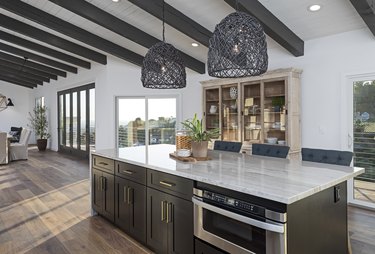
Replacing old laminate countertops with granite can make a big difference in your kitchen's appearance, but the cost of stone countertops might exceed your budget. Instead of learning to live with your existing counters, you can dress them up with a faux painting technique and some standard paint supplies. Before you start painting, look for a granite tile to serve as inspiration. This will help you choose the appropriate countertop paint colors for your laminate countertops.
Pre-Paint Sanding and Cleaning
Video of the Day
Sand the laminate kitchen countertops with coarse-grit sandpaper to create a textured surface on which the paint and sealer will more easily adhere than the smoother untreated laminate. Clean the countertops thoroughly with warm soapy water to remove any dust created during the sanding process. Dry the countertops with a clean towel before you begin painting.
Video of the Day
Applying Primer to Countertops
Apply one coat of alcohol-based primer to the countertops with a paint roller. Choose a primer that is formulated for sealing a non-porous surface. The color of the primer is not important because you will cover it with another layer of paint. It's important that you allow the primer to dry thoroughly before applying the paint, so check the product label to find the recommended drying time.
Choosing Countertop Paint Colors
Choose four colors for your faux granite paint effect and purchase these colors in satin or flat latex paints. One color will be the base color and the other three colors will be the accent colors.
Applying Kitchen Countertop Paint Base
Paint the dry countertops with the paint tinted to the base color of your granite. If you need to apply a second coat of paint to completely cover the primer, do so when the first coat is completely dry.
Sponging Accent Colors Onto Base
Pour some of the paint tinted to your first accent color into a paint tray. Dip a natural sea sponge into the paint and pat the sponge lightly onto the dry painted countertop. Continue to do this over the entire countertop to create a random pattern.
Sponge-paint another accent color randomly over the first accent color when the first accent color is dry. The countertop now has a base color with two different colors sponge-painted on top of it.
Applying the Third Accent Color
Pour a small amount of the third accent color into a paint tray and add an equal amount of water to create a thin glaze. Dip a stiff-bristle paintbrush into the glaze and shake the paintbrush over the countertop to create a splattered effect with the glaze. This random application will help create a realistic granite appearance.
Applying the Polyurethane Sealer
Apply three coats of oil-based polyurethane to the countertops with a paint roller when the glaze is completely dry. Let each coat of polyurethane dry according to the directions on the can, or for at least four hours, before you begin to apply the next. When the polyurethane is completely dry, sand the dry polyurethane with extra-fine-grit sandpaper until it feels smooth.